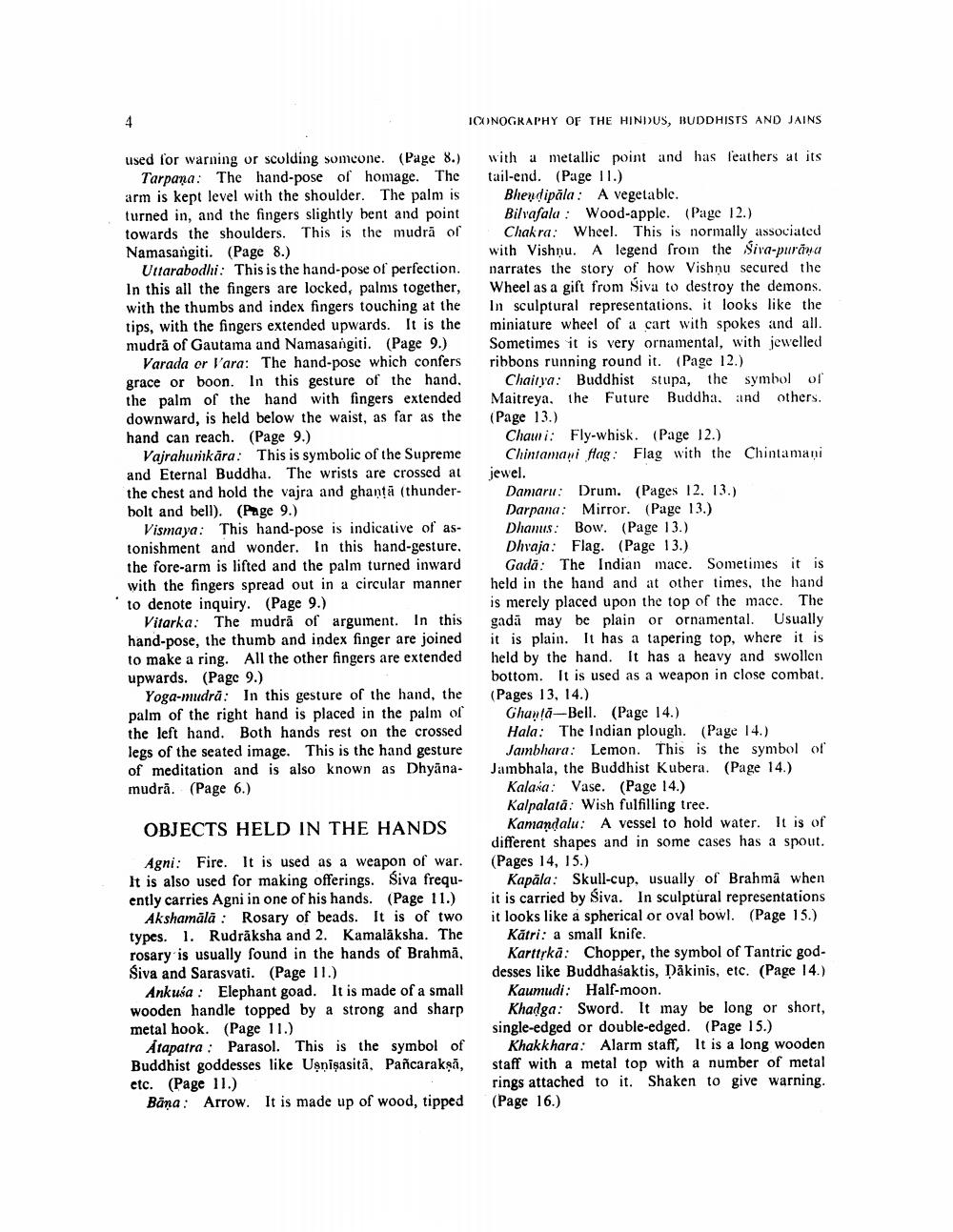________________
4
used for warning or scolding someone. (Page 8.) Tarpana: The hand-pose of homage. The arm is kept level with the shoulder. The palm is turned in, and the fingers slightly bent and point towards the shoulders. This is the mudra of Namasangiti. (Page 8.)
Uttarabodhi: This is the hand-pose of perfection. In this all the fingers are locked, palms together, with the thumbs and index fingers touching at the tips, with the fingers extended upwards. It is the mudra of Gautama and Namasangiti. (Page 9.)
Varada or Vara: The hand-pose which confers. grace or boon. In this gesture of the hand. the palm of the hand with fingers extended downward, is held below the waist, as far as the hand can reach. (Page 9.)
Vajrahumkara: This is symbolic of the Supreme and Eternal Buddha. The wrists are crossed at the chest and hold the vajra and ghanță (thunderbolt and bell). (Page 9.)
Vismaya: This hand-pose is indicative of astonishment and wonder. In this hand-gesture. the fore-arm is lifted and the palm turned inward with the fingers spread out in a circular manner to denote inquiry. (Page 9.)
Vitarka: The mudra of argument. In this hand-pose, the thumb and index finger are joined to make a ring. All the other fingers are extended upwards. (Page 9.)
Yoga-mudra: In this gesture of the hand, the palm of the right hand is placed in the palm of the left hand. Both hands rest on the crossed legs of the seated image. This is the hand gesture of meditation and is also known as Dhyanamudra. (Page 6.)
ICONOGRAPHY OF THE HINDUS, BUDDHISTS AND JAINS
with a metallic point and has feathers at its tail-end. (Page 11.)
OBJECTS HELD IN THE HANDS
Agni: Fire. It is used as a weapon of war. It is also used for making offerings. Śiva frequently carries Agni in one of his hands. (Page 11.) Akshamālā: Rosary of beads. It is of two types. 1. Rudraksha and 2. Kamalaksha. The rosary is usually found in the hands of Brahma, Siva and Sarasvati. (Page 11.)
Ankusa: Elephant goad. It is made of a small wooden handle topped by a strong and sharp metal hook. (Page 11.)
Atapatra Parasol. This is the symbol of Buddhist goddesses like Usnīṣasitā. Pañcarakṣā, etc. (Page 11.)
Bāna: Arrow. It is made up of wood, tipped
Bhenḍipala: A vegetable.
Bilvafala: Wood-apple. (Page 12.)
Chakra: Wheel. This is normally associated with Vishnu. A legend from the Siva-purana narrates the story of how Vishnu secured the Wheel as a gift from Siva to destroy the demons. In sculptural representations. it looks like the miniature wheel of a cart with spokes and all. Sometimes it is very ornamental, with jewelled ribbons running round it. (Page 12.)
Chaitya: Buddhist stupa, the symbol of Maitreya, the Future Buddha. and others. (Page 13.)
Chami: Fly-whisk. (Page 12.)
Chintamani flag: Flag with the Chintamani jewel.
Damaru: Drum. (Pages 12. 13.)
Darpana: Mirror. (Page 13.) Dhanus: Bow. (Page 13.) Dhvaja: Flag. (Page 13.)
Gada: The Indian mace. Sometimes it is held in the hand and at other times, the hand is merely placed upon the top of the mace. The gadā may be plain or ornamental. Usually it is plain. It has a tapering top, where it is held by the hand. It has a heavy and swollen bottom. It is used as a weapon in close combat. (Pages 13, 14.)
Ghanta-Bell. (Page 14.)
Hala: The Indian plough. (Page 14.) Jambhara: Lemon. This is the symbol of Jambhala, the Buddhist Kubera. (Page 14.) Kalasa: Vase. (Page 14.)
Kalpalata: Wish fulfilling tree.
Kamandalu: A vessel to hold water. It is of different shapes and in some cases has a spout. (Pages 14, 15.)
Kapala: Skull-cup, usually of Brahma when it is carried by Siva. In sculptural representations it looks like a spherical or oval bowl. (Page 15.) Kätri: a small knife.
Karttrka: Chopper, the symbol of Tantric goddesses like Buddhaśaktis, Dakinis, etc. (Page 14.) Kaumudi: Half-moon.
Khadga: Sword. It may be long or short, single-edged or double-edged. (Page 15.)
Khakkhara: Alarm staff, It is a long wooden staff with a metal top with a number of metal rings attached to it. Shaken to give warning. (Page 16.)




